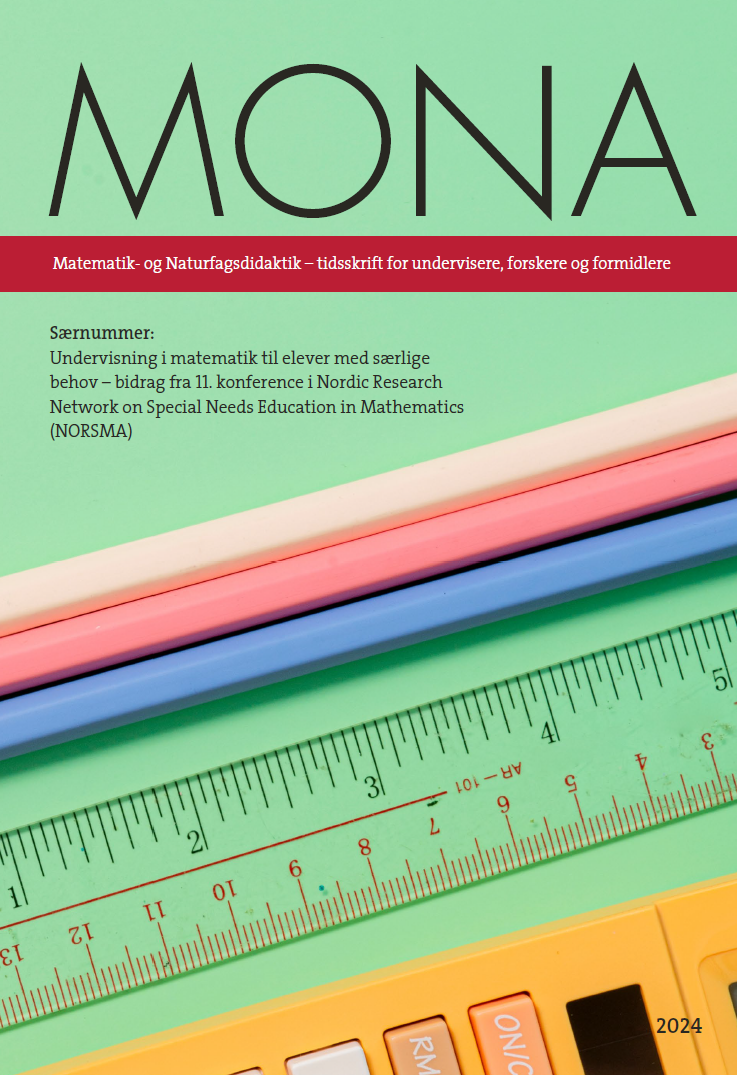Resumé
Artiklen beskriver elementer i et udviklingsarbejde som sigter efter at forbedre elevers talforståelse gennem tidlig og målrettet indsats. En test til bestemmelse af elevers talforståelse og dens tilblivelse beskrives, efterfulgt af en kort beskrivelse af indhold, organisering og resultater af målrettet indsats på tre niveauer. Artiklen trækker på både praktisk erfaring og teori og forskning inden for det matematikdidaktiske felt og fokuserer på elevers udvikling af talforståelse og hvordan denne kan belyses. Testresultater fra 2021‑2024 tyder på at den målrettede indsats har betydet en bedre talforståelse hos skolens elever.
Referencer
Boaler, J. (2016). Mathematical Mindsets: Unleashing Students’ Potential Through Creative Math, Inspiring Messages, and Innovative Teaching. Jossey-Bass & Pfeiffer Imprints.
Bruner, J. S. & Kenney, H. J. (1965). Representation and Mathematics Learning. Monographs of the Society for Research in Child Development, 30(1), 50‑59. https://doi.org/10.2307/1165708
Clements, D. & Sarama, J. (2007). Early Childhood Mathematics Learning. I F. K. Lester Jr. (red.), Second Handbook of Research on Mathematics Teaching and Learning (s. 461‑555). Information Age Publishing.
Egmont Fonden. (2023). Egmont Rapporten 2023. Regn med os – bedre hjælp til børn og unge i matematikvanskeligheder. Egmont Fonden. https://api.communications.egmont.com/sites/default/files/2024‑04/Egmont%20Rapporten%202023.pdf
Feigenson, L., Dehaene, S. & Spelke, E. (2004). Core Systems of Number. Trends in Cognitive Sciences, 8(7), 307‑314. https://doi.org/10.1016/j.tics.2004.05.002
Hiebert, J. & Carpenter, T. P. (1992). Learning and Teaching with Understanding. I D. A. Grouws (red.), Handbook of Research on Mathematics Teaching and Learning: A Project of the National Council of Teachers of Mathematics (s. 65‑97). Macmillan Publishing.
Laski, E. V. & Siegler, R. S. (2007). Is 27 a Big Number? Correlational and Causal Connections Among Numerical Categorization, Number Line Estimation, and Numerical Magnitude Comparison. Child Development, 78(6), 1723‑1743. https://doi.org/10.1111/j.1467‑8624.2007.01087.x
Lindenskov, L. & Lindhardt, B. (2023). Vidensopsamling – elever i matematikvanskeligheder. Egmont Fonden. https://pure.au.dk/ws/portalfiles/portal/358821649/Vidensopsamling_-_Elever_i_matematikvanskeligheder.pdf
Markovits, Z. & Sowder, J. (1994). Developing Number Sense: An Intervention Study in Grade 7. Journal for Research in Mathematics Education, 25(1), 4‑29. https://doi.org/10.2307/749290
Nguyen, T., Watts, T. W., Duncan, G. J., Clements, D. H., Sarama, J. S., Wolfe, C. & Spitler, M. E. (2016). Which Preschool Mathematics Competencies Are Most Predictive of Fifth Grade Achievement? Early Childhood Research Quarterly, 36, 550‑560. https://doi.org/10.1016/j.ecresq.2016.02.003
Noël, M.-P. & Rousselle, L. (2011). Developmental Changes in the Profiles of Dyscalculia: An Explanation Based on a Double Exact-And-Approximate Number Representation Model. Frontiers in Human Neuroscience, 5, 165. https://doi.org/10.3389/fnhum.2011.00165
Sfard, A. (1991). On the Dual Nature of Mathematical Conceptions: Reflections on Processes and Objects as Different Sides of the Same Coin. Educational Studies in Mathematics, 22(1), 1‑36. https://doi.org/10.1007/BF00302715
Sowder, J. T. (1992). Estimation and Number Sense. I D. A. Grouws (red.), Handbook of Research on Mathematics Teaching and Learning: A Project of the National Council of Teachers of Mathematics (s. 371‑389). Macmillan Publishing.
Thompson, M. & Riedel, D. (2021). Helsingør testen. Helsingør Kommune. https://sites.google.com/g.helsingor.dk/matematik/test
Wilson, A. J. & Dehaene, S. (2007). Number Sense and Developmental Dyscalculia. I D. Coch, G. Dawson & K. W. Fischer (red.), Human Behavior, Learning, and the Developing Brain: Atypical Development (s. 212‑237). Guilford Press.

